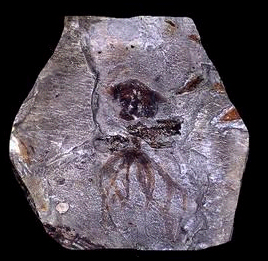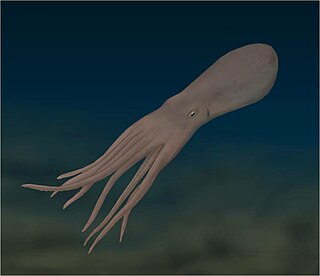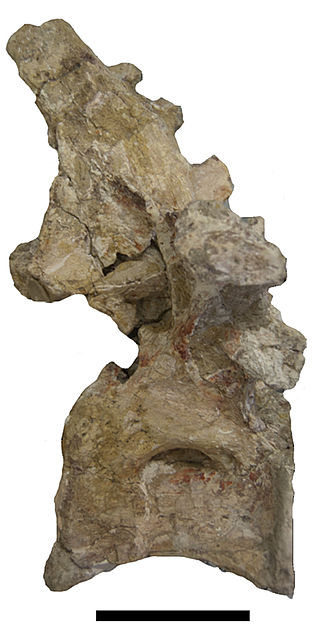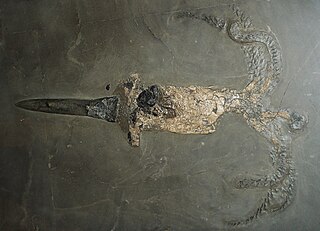
The Cretaceous is a geological period that lasted from about 143.1 to 66 million years ago (Mya). It is the third and final period of the Mesozoic Era, as well as the longest. At around 77 million years, it is the ninth and longest geological period of the entire Phanerozoic. The name is derived from the Latin creta, 'chalk', which is abundant in the latter half of the period. It is usually abbreviated K, for its German translation Kreide.

Ampelosaurus is a titanosaurian sauropod dinosaur from the Late Cretaceous Period of what is now France. Its type species is A. atacis, named by Le Loeuff in 1995. Its remains were found in a level dating from 71.5 million years ago representing the early Maastrichtian.

Variraptor is a possibly dubious and potentially chimaeric genus of dromaeosaurid theropod dinosaur from the Late Cretaceous of France.

Palaeoctopus is an extinct genus of octopuses that lived during the Late Cretaceous. It contains one valid species, P. newboldi, which has been found in Lebanon.
Argiles et Grès à Reptiles Formation also known as the Argiles Rutilantes Formation is an early Maastrichtian French geologic formation in the département of Var preserving the remains of several types of dinosaurs and other extinct organisms.

The Cerro del Pueblo Formation is a geological formation in Coahuila, Mexico, whose strata date back to the latest Campanian of the Late Cretaceous, just before the Campanian-Maastrichtian boundary. Dinosaur remains are among the fossils that have been recovered from the formation. The formation is believed to correlate with the Baculites reesidesi and Baculites jenseni ammonite zones, which dates it to 73.63-72.74 Ma.

Paleontology or palaeontology is the study of prehistoric life forms on Earth through the examination of plant and animal fossils. This includes the study of body fossils, tracks (ichnites), burrows, cast-off parts, fossilised feces (coprolites), palynomorphs and chemical residues. Because humans have encountered fossils for millennia, paleontology has a long history both before and after becoming formalized as a science. This article records significant discoveries and events related to paleontology that occurred or were published in the year 2009.
Styletoctopus is an extinct genus of octopus. The genus consists of the single species Styletoctopus annae, which lived approximately 95 million years ago during the late Cenomanian,. It was first discovered in 2009 by a team led by Dirk Fuchs of Freie University in the Hâqel and Hjoula localities in Lebanon. Very few octopus species appear in the fossil record, as octopuses consist of soft tissue that usually decomposes before it has time to fossilize.

Keuppia is an extinct genus of octopus.
Microsuchus is an extinct genus of mesoeucrocodylians, belonging to Notosuchia. Fossils have been found in the Bajo de la Carpa Formation, dating to the Santonian stage of the Late Cretaceous.

Musturzabalsuchus is an extinct monospecific genus of allodaposuchid eusuchian crocodyliform. The type and only species is Musturzabalsuchus buffetauti.

Atsinganosaurus is a genus of titanosaurian sauropod dinosaur which existed in what is now France during the Late Cretaceous. Well-preserved remains of Atsinganosaurus were collected from the Grès à Reptiles Formation of the Aix-en-Provence Basin. The type and only species is A. velauciensis.

Belemnitida is an extinct order of squid-like cephalopods that existed from the Late Triassic to Late Cretaceous. Unlike squid, belemnites had an internal skeleton that made up the cone. The parts are, from the arms-most to the tip: the tongue-shaped pro-ostracum, the conical phragmocone, and the pointy guard. The calcitic guard is the most common belemnite remain. Belemnites, in life, are thought to have had 10 hooked arms and a pair of fins on the guard. The chitinous hooks were usually no bigger than 5 mm (0.20 in), though a belemnite could have had between 100 and 800 hooks in total, using them to stab and hold onto prey.

Dorateuthis is a genus of cephalopod from the Upper Santonian shale of Late Cretaceous Lebanon. Though traditionally regarded as a plesioteuthidid squid, it may instead be a member of the suborder Prototeuthina, the earliest-diverging branch of Octopoda. Dorateuthis was small, with a mantle length of 5–40 cm (2.0–15.7 in). The contents of its digestive system suggest that it may have fed on small fishes and been an active predator.

Agathoxylon is a form genus of fossil wood, including massive tree trunks. Although identified from the late Palaeozoic to the end of the Mesozoic, Agathoxylon is common from the Carboniferous to Triassic. Agathoxylon represents the wood of multiple conifer groups, including both Araucariaceae and Cheirolepidiaceae, with late Paleozoic and Triassic forms possibly representing other conifers or other seed plant groups like "pteridosperms".

The Oulad Abdoun Basin is a phosphate sedimentary basin located in Morocco, near the city of Khouribga. It is the largest in Morocco, comprising 44% of Morocco's phosphate reserves, and at least 26.8 billion tons of phosphate. It is also known as an important site for vertebrate fossils, with deposits ranging from the Late Cretaceous (Cenomanian-Turonian) to the Eocene epoch (Ypresian), a period of about 25 million years.
Hjoula is a municipality in the Byblos District of Keserwan-Jbeil Governorate, Lebanon. It is 70 kilometres (43 mi) north of Beirut. Hjoula has an elevation of between 920 and 1,100 m above sea level. Hjoula has a total land area of 528 hectares. The village of Hjoula is known for its fertile soil and its woods, as well as Late Cretaceous fossils.
This list, 2018 in paleomalacology, is a list of new taxa of ammonites and other fossil cephalopods, as well as fossil gastropods, bivalves and other molluscs that are scheduled to be described during the year 2018, as well as other significant discoveries and events related to molluscan paleontology that are scheduled to occur in the year 2018.
Garrigatitan is a genus of titanosaurian dinosaur from the late Cretaceous Period of the Grès à Reptiles Formation in France. The genus contains a single species, Garrigatitan meridionalis.
Eromangateuthis is an extinct genus of large plesioteuthidid cephalopod from the Cretaceous of Australia and possibly Canada.













